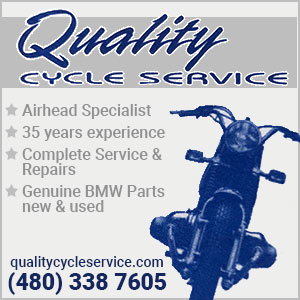R100GS - Clutch Adjustment
Hello all,
Still a newbie to BMW Airheads, so please bear with me.
This R100GS has relatively high mileage, 117K klicks (~73K Miles) so that has to be considered. I'm the most recent owner and have no history for the bike as it was purchased from a dealer. That said, the bike is 100% box-stock, from what I can find, except recent beancan mods installed by me. I installed a Mottorad Elektric ignition and I'm real happy with it. The ignition was installed to solve a hot, high, idle problem and it certainly has done that. However, while doing the ignition install, I noticed slightly unstable timing readings and put that down to possible timing chain issues - something to look in to. I set up the new, electronic, timing at the max advance condition and let the idle fall where it may. I'm pretty sure I have the carb balancing OK and the valve adjustments are right on, no vac leaks, etc, etc.
I'm getting a "rattling?" noise from the engine when stopped, idling (approx 1100 rpm), hot (or cold, for that matter) that goes away if I pull in the clutch. Hard to describe, but it sounds like gear chatter - where the gearing is clicking back and forth between engaged teeth.
Is this a reasonable description of timing chain "clatter" from a worn out timing train? Or. Is it indicative of something else?
I looked into the clutch adjustment and it was way out of spec. I cut off a 201mm piece of dowel to use as a template for the clutch lever position. Then set up the clutch according to the owner's manual: back off the handlebar adjustment until I got the 201mm dowel to fit between the forward face of the transmission clutch lever and the aft face of the transmission case. Then adjusted the screw on the input end of the transmission clutch lever to give me ~2mm of play (between the handlebar lever housing and the forward edge of the handlebar lever) at the handlebar clutch lever. I'm pretty much out of adjustment now. There's maybe two threads left before bottoming the transmission adjustment screw against the locknut.
This process has not quieted down the noise. The clutch seems to work about the same as it did before I went for the adjustment. There is a large difference between the settings now, verses before the adjustment. Before adjusting, there was approx 1/4 inch of (outward) adjustment at the handlebar end of the clutch cable and five or six threads between the bottom of the lower adjustment screw and it's locknut. The distance between the transmission housing and the forward face of the lower clutch lever was maybe (I didn't measure) 195 - 198mm. I haven't ridden the bike in this condition, yet. Maybe tomorrow. However, the clutch pull feels good and the transmission shifts just fine running on the centrestand.
Comments from the knowledgeable would be appreciated.
Common sense isn't very common, any more.
Some thoughts from a fellow BMW novice...
• Some timing strobe lamps need an independent power source to give a really accurate timing report. The impulses from several sources can end up in the motorcycle battery and if the power for the strobe is taken from the motorcycle, then the timing mark seems to jump around. Try connecting the lamp to your 12V battery charger or car battery next time.
• The airhead "timing chain" spins the camshaft, thereby affecting the cam and ignition timing. Cam timing is not nearly as demanding as ignition timing. A worn cam chain will make noise at idle and eventually chew up the chain guides. If you suspect a worn timing chain, then the optimal method is to set the ignition timing while the engine is running at full advance (high RPM) using the 'F' mark.
That being said, cam chain replacement is a typically a straight forward job that can be completed in the home shop in an afternoon. This is the perfect off-season winter project.
• Clutch lever adjustment is a compromise between the needs of the clutch and the requirements of the human hand. The clutch wants to disengage as far as possible, therefore it wants to engage with the lever about 90% released. The human hand may not have full strength at that long reach, and so wants clutch engagement to happen closer to the grip, say 50% released. Further out is always more desirable, but may not be physically possible.
No matter what adjustment you finally decide upon, 2 things must always be true: 1) There should always be some amount of free play in the clutch cable when the clutch lever is at rest. 2) One should never stop in traffic without selecting the gearbox "neutral" and releasing the clutch lever to rest.
Hope this helps.
Owning an old Airhead is easy.
Keeping an old Airhead running great is the true test.
Thanks @Wobbly,
I did set the timing at Max - see quote from above - " I set up the new, electronic, timing at the max advance condition and let the idle fall where it may. " Only way I know to do it if the chain is flapping around. Used to wrench on Alpha Romeos in the sixties. Those were bad tensioners. I'm going to have to take the cover off and (at least) inspect the chain and tensioner(s). As long as I'm not doing any damage to the innards, I'll leave the replacement until the fall. If I find any serious looking problems, I'll do the chain sprocket replacement sooner rather than later. One of my biggest worries is the fact that I have to do this in the underground garage at my condo. Not the best working environment - but it is what it is. Going to be fun getting a hot sprocket out of the oven and down to the garage fast enough to fit. I think the hot plate and warm oil route is not going to be approved by the condo association. I'm going to bet that it won't be approved by SWMBO.
I rode the bike approx 100 Km yesterday. Clutch operation is fine.
EDIT: Text following has been removed and re-posted in a separate subject under "Wrenching - Hydraulic Lift"
Common sense isn't very common, any more.
Thanks for the comments @8166. I have moved the lift portion of the post to "Wrenching - Hydraulic Lift" at your suggestion.
Common sense isn't very common, any more.
Back to your original question, the rattle you describe sounds like normal operation, especially if it's coming from the gear box, and especially if the carbs aren't properly synced. Go for a ride long enough to get the carbs almost too hot to touch, the follow Bob "Snowbum" Fleischer's synch procedure on his web site. That may significantly reduce the noise.
Man is this ever great advice!!
It seems like almost every "ill" on my bike has been corrected or made less significant by better carb adjustment. I've been adjusting British bikes by ear for years, but for some reason the Airheads really do need the use of a tool to cut down the noise and get the smoothest ride. My brother went and bought the electronic carb balancer, but it's no more accurate than the manometer I constructed for $3 using these instructions...
http://www.powerchutes.com/manometer.asp
If you only own one tool for your Airhead, this would be it !! Having a good adjustment on your carbs will completely change the entire character of your machine.
Owning an old Airhead is easy.
Keeping an old Airhead running great is the true test.
Went out to a local m/c shop yesterday and got two old spokes and two spoke nipples. Now all I need is a big fan and a long extension cord. I'll get to this next week and report back on progress.
Gone Sailing!
Common sense isn't very common, any more.
- 27 Forums
- 1,801 Topics
- 10.2 K Posts
- 6 Online
- 5,524 Members





